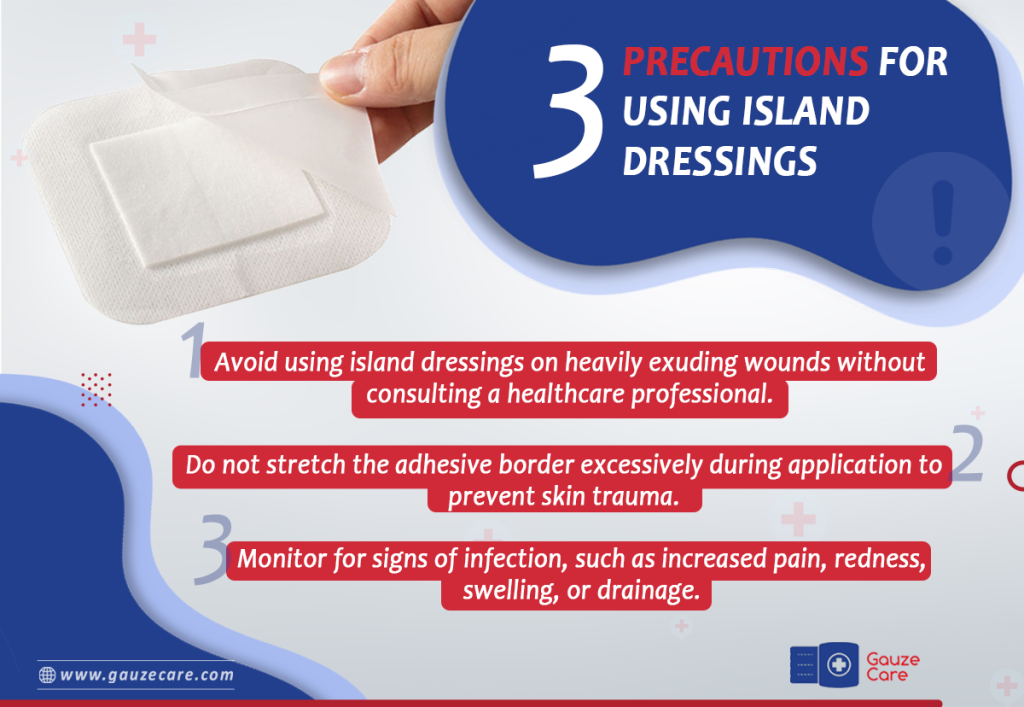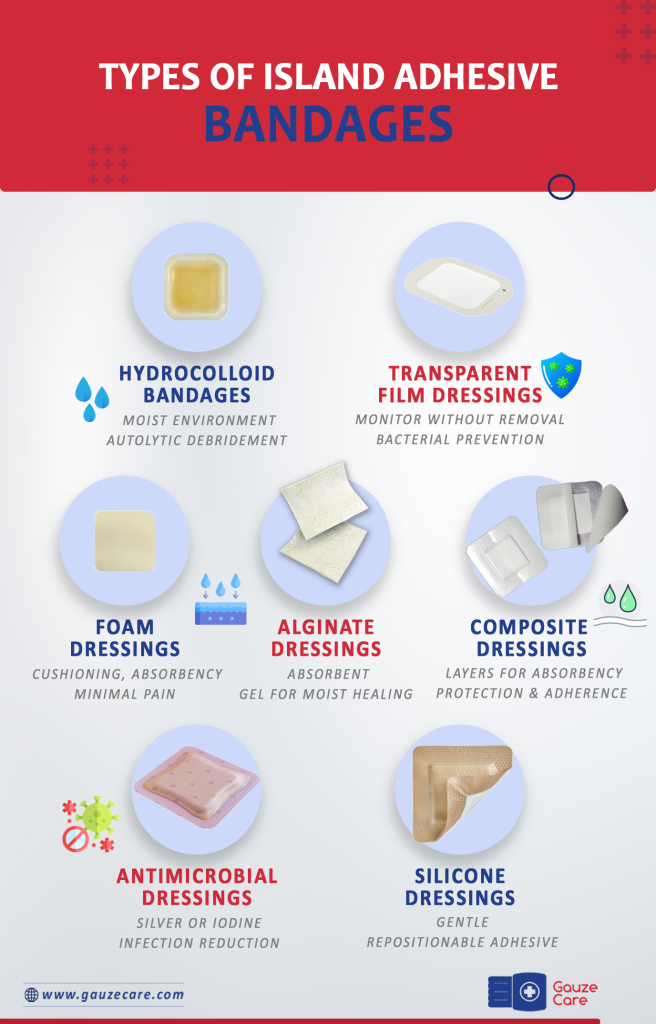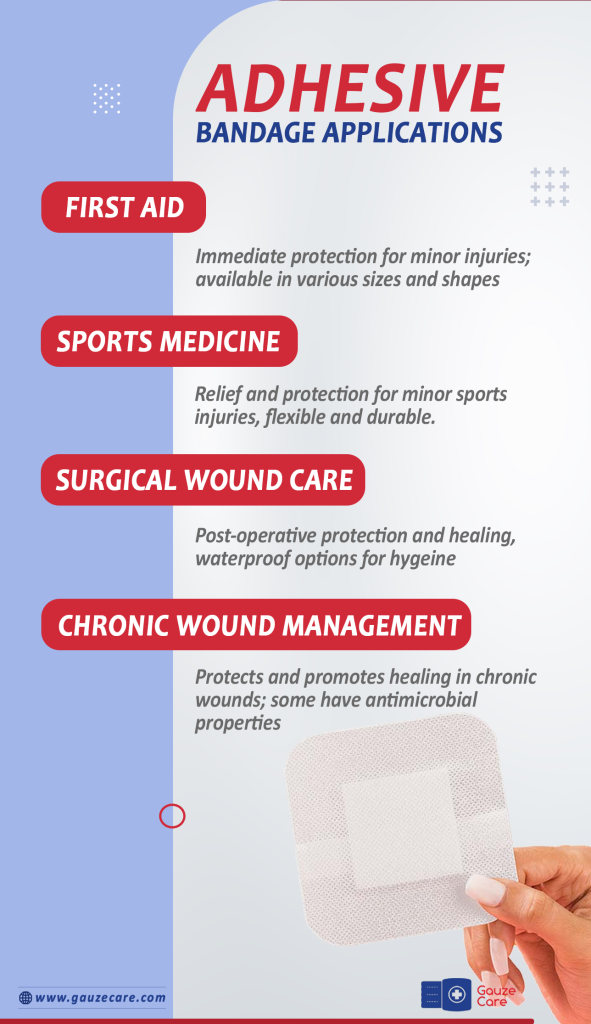In the realm of wound care, island dressing bandages stand as stalwart guardians, shielding injuries from external contaminants while fostering an optimal environment for healing. But what precisely distinguishes these adhesive marvels, and how do they operate at the intersection of functionality and innovation? This article delves deep into the technical intricacies of island dressing bandages, elucidating their composition, applications, and the scientific rationale underlying their efficacy.
The Ingenious Mechanism of Island Dressing Bandages

Understanding Island Dressing Bandages
Island dressing bandages, also known as adhesive island dressings, represent a pinnacle in wound management technology. Their design comprises a central absorbent pad, often imbued with antimicrobial properties, encased within a waterproof adhesive border. This configuration offers a multifaceted approach to wound care, combining absorbency, protection, and adherence in a single application.
Composition and Mechanism
The adhesive island dressing’s prowess arises from its composite structure. The absorbent pad, typically composed of non-adherent materials such as alginate or foam, serves as a reservoir for exudate while preventing adherence to the wound bed. Surrounding this pad, the adhesive border forms a seal, safeguarding the periphery of the wound from microbial invasion and maintaining a sterile environment conducive to healing.
Applications and Benefits
The versatility of island dressing bandages renders them indispensable across various clinical scenarios. These dressings offer unparalleled protection and comfort from minor abrasions to surgical incisions. Their waterproof nature ensures durability even in challenging environments, making them ideal for patients with active lifestyles or those requiring prolonged wear. Moreover, antimicrobial agents within the absorbent pad mitigate the risk of infection, further enhancing the healing process.
Types of Adhesive Bandages
Beyond the realm of island dressing bandages, adhesive bandages encompass various configurations tailored to address various wound types and patient preferences. Understanding the nuances of these different types elucidates the breadth of options available in modern wound care.

Hydrocolloid Bandages
Hydrocolloid bandages feature a gel-forming adhesive that interacts with wound exudate to create a moist environment conducive to healing. These dressings are particularly effective for shallow wounds with moderate exudate levels, providing both absorbency and protection against external contaminants. Their occlusive nature promotes autolytic debridement, facilitating the removal of necrotic tissue while minimizing trauma to healthy skin.
Transparent Film Dressings
Transparent film dressings comprise a thin, adhesive film that adheres to the skin without obstructing the visibility of the wound. This transparency allows for easy monitoring of wound progression without the need for frequent dressing changes. Moreover, the impermeable nature of these dressings prevents bacterial infiltration while allowing for moisture vapor transmission, maintaining a moist wound environment essential for optimal healing.
Foam Dressings
Foam dressings are characterized by their soft, absorbent material, which provides cushioning and protection to wounds with varying exudate levels. The porous structure of foam dressings facilitates fluid absorption while minimizing maceration of surrounding skin. Additionally, the non-adherent surface prevents adherence to the wound bed, reducing pain and trauma during dressing changes. Foam dressings are particularly well-suited for highly exuding wounds or those requiring extended wear time.
Alginate Dressings
Alginate dressings derive from seaweed and exhibit remarkable absorbent properties, making them ideal for heavily exuding wounds. Upon contact with wound exudate, alginate dressings form a gel-like consistency, creating a moist environment that promotes autolytic debridement and accelerates the healing process. These dressings are highly conformable and can be easily packed into deep or irregularly shaped wounds, making them a versatile option for advanced wound care.
Composite Dressings
Composite dressings combine multiple layers of different materials to provide a comprehensive solution to wound management. Typically, these dressings consist of a non-adherent contact layer, an absorbent core, and an outer waterproof barrier. This layered construction offers superior absorbency, protection, and adherence, making composite dressings suitable for a wide range of wounds, including surgical incisions, abrasions, and lacerations.
Antimicrobial Dressings
Antimicrobial dressings incorporate agents such as silver or iodine to inhibit microbial growth and reduce the risk of infection. These dressings are particularly beneficial for wounds at high risk of contamination or those exhibiting signs of infection. By creating a hostile environment for bacteria, antimicrobial dressings promote wound healing while minimizing the need for systemic antibiotics, thereby reducing the risk of antibiotic resistance.
Silicone Dressings
Silicone dressings feature a gentle adhesive that adheres to the skin without causing trauma or irritation, making them suitable for sensitive or fragile skin types. These dressings are highly conformable and can be easily repositioned without losing their adhesive properties, allowing for optimal wound coverage and patient comfort. Silicone dressings are particularly favored for wounds in areas prone to movement, such as joints or flexor surfaces.
Adhesive Bandage Applications
The versatility of adhesive bandages extends beyond wound management, encompassing a myriad of applications in both clinical and non-clinical settings. From first aid to post-operative care, these versatile dressings serve as indispensable tools in promoting healing and maintaining skin integrity.

First Aid
Adhesive bandages are a staple in any first aid kit, offering immediate protection and comfort for minor cuts, scrapes, and abrasions. Their ease of application and portability make them indispensable for addressing injuries in diverse settings, from the home to the workplace to outdoor adventures. Moreover, the availability of different sizes and shapes ensures optimal coverage for wounds of varying severity, facilitating rapid healing and minimizing the risk of complications.
Surgical Wound Care
In surgical settings, adhesive bandages play a crucial role in post-operative wound care, providing a barrier against external contaminants while promoting wound healing. Following surgical procedures, these dressings are applied to incision sites to facilitate tissue approximation and prevent complications such as infection or dehiscence. Additionally, the waterproof properties of certain adhesive bandages allow patients to shower or bathe without compromising dressing integrity, enhancing post-operative comfort and hygiene.
Sports Medicine
Athletes and sports enthusiasts rely on adhesive bandages to address minor injuries and prevent further damage during athletic activities. Whether it’s a blister, abrasion, or minor laceration, these dressings offer immediate relief and protection, allowing athletes to continue training or competing without interruption. Moreover, the flexibility and durability of adhesive bandages make them suitable for use in dynamic environments, where movement and perspiration are commonplace.
Chronic Wound Management
For patients with chronic wounds such as pressure ulcers or diabetic foot ulcers, adhesive bandages play a pivotal role in wound care and prevention of complications. By providing a protective barrier and promoting moisture balance, these dressings facilitate the healing process and prevent exacerbation of existing wounds. Additionally, the antimicrobial properties of certain adhesive bandages help reduce the risk of infection in vulnerable patient populations, enhancing overall wound outcomes.
Adhesive Bandages in Veterinary Medicine
While the application of adhesive bandages is predominantly associated with human healthcare, their utility extends to the realm of veterinary medicine, where they serve as invaluable tools in addressing injuries and promoting healing in companion animals and livestock alike.
Wound Management in Companion Animals
Dogs, cats, and other companion animals are prone to injuries ranging from minor cuts and abrasions to surgical incisions. Adhesive bandages provide a convenient and effective means of protecting these wounds from further trauma and contamination. Whether it’s a paw pad laceration, a tail abrasion, or a surgical site incision, these dressings offer immediate relief and facilitate the healing process in pets. Moreover, the availability of hypoallergenic and breathable variants ensures optimal comfort for animals with sensitive skin or allergies.
Equine Wound Care
Horses are susceptible to a myriad of injuries, including lacerations, puncture wounds, and abrasions, often resulting from accidents or interactions with their environment. Adhesive bandages play a crucial role in equine wound care, providing protection and support to injured tissues while minimizing the risk of infection. From leg wraps to chest bandages to tail dressings, these versatile dressings offer tailored solutions for wounds of varying sizes and locations in horses, facilitating rapid healing and preventing complications.
Livestock Wound Healing
Livestock such as cattle, sheep, and goats are also prone to injuries that require prompt attention and appropriate wound management strategies. Adhesive bandages serve as valuable assets in the livestock industry, where the health and welfare of animals directly impact productivity and profitability. Whether it’s a hoof injury, an udder abrasion, or a surgical wound, these dressings provide an effective means of promoting healing and preventing secondary infections in livestock, thereby safeguarding animal well-being and ensuring optimal production outcomes.
Innovations in Adhesive Bandage Technology
The evolution of adhesive bandage technology continues to drive innovation and enhance the efficacy of these indispensable wound-care tools. Recent advancements encompass a spectrum of features aimed at optimizing comfort, functionality, and therapeutic outcomes for patients across diverse clinical scenarios.
Advanced Adhesive Formulations
The development of novel adhesive formulations has led to significant improvements in dressing adherence and skin compatibility. Silicone-based adhesives, for instance, offer gentle yet secure fixation without causing skin irritation or trauma, making them ideal for sensitive or fragile skin types. Moreover, hydrocolloid adhesives with enhanced moisture management properties facilitate optimal wound healing by creating a moist environment conducive to tissue regeneration.
Antimicrobial Integration
The integration of antimicrobial agents into adhesive bandage formulations represents a proactive approach to infection prevention and control. Silver nanoparticles, iodine, and other antimicrobial agents exhibit broad-spectrum activity against bacteria, fungi, and other pathogens commonly implicated in wound infections. By incorporating these agents into adhesive dressings, healthcare providers can mitigate the risk of infection and promote faster healing, particularly in high-risk patient populations or wounds prone to contamination.
Smart Dressing Technologies
The emergence of smart dressing technologies heralds a new era in wound management, where dressings are equipped with sensors and monitoring capabilities to provide real-time feedback on wound status and healing progression. These intelligent dressings can detect changes in temperature, pH, moisture levels, and other biomarkers indicative of wound healing or complications. By empowering healthcare providers with actionable data, smart dressing technologies enhance decision-making and optimize treatment strategies for improved patient outcomes.
Biodegradable Materials
With growing emphasis on sustainability and environmental stewardship, there is increasing interest in developing biodegradable adhesive bandage materials that minimize ecological footprint without compromising performance. Biopolymers derived from renewable sources such as plant starch, cellulose, and chitosan offer promising alternatives to traditional petroleum-based materials. These biodegradable dressings degrade naturally over time, reducing waste accumulation and environmental impact while promoting sustainable healthcare practices.
Application and Removal
The application of island dressing bandages demands precision and adherence to established protocols to maximize efficacy and minimize discomfort. Before application, the wound must be cleansed and dried to ensure optimal adhesion. Care should be taken to center the absorbent pad over the wound site, with the adhesive border extending beyond the margins for secure fixation. Upon removal, gentle traction along the skin’s surface facilitates painless detachment, mitigating the risk of trauma to the wound bed.
Common Queries Answered
What type of dressing is island dressing?
Island dressing bandages belong to the category of adhesive medical dressings, characterized by their composite structure comprising an absorbent pad and adhesive border.
How long can island dressing stay on?
The duration of wear for island dressing bandages varies depending on the wound type and exudate levels. Generally, they can remain in place for several days, provided there are no signs of leakage or compromised integrity.
Conclusion
In essence, adhesive bandages stand as a cornerstone in modern wound care, offering a diverse array of options tailored to address specific wound types and patient needs, from hydrocolloid dressings to transparent films to silicone-based variants. These versatile dressings embody innovation and functionality at the intersection of science and patient care. By understanding the nuances of adhesive bandage types and applications, healthcare professionals can optimize wound management strategies, promoting optimal healing outcomes across diverse clinical scenarios in both human healthcare and veterinary medicine. By harnessing the latest advancements in adhesive bandage technology and embracing interdisciplinary collaboration, healthcare providers can optimize wound management strategies for both patients and animals.
